Nonspontaneous - Study guides, Class notes & Summaries
Looking for the best study guides, study notes and summaries about Nonspontaneous? On this page you'll find 96 study documents about Nonspontaneous.
Page 4 out of 96 results
Sort by
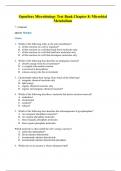
-
OpenStax Microbiology Test Bank Chapter 8: Microbial Metabolism
- Exam (elaborations) • 12 pages • 2024
- Available in package deal
-
- $16.50
- + learn more
OpenStax Microbiology Test Bank Chapter 8: Microbial Metabolism * = Correct answer Multiple Choice 1. Which of the following refers to the term metabolism? A. all the reactions in a cell or organism* B. all the reactions in a cell that break down molecules only C. all the reactions in a cell that build new molecules only D. all the reactions in a cell that decompose molecules only 2. Which of the following best describes an endergonic reaction? A. absorbs energy from the environment*...
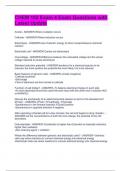
-
CHEM 102 Exam 4 Exam Questions with Latest Update
- Exam (elaborations) • 3 pages • 2024
-
Available in package deal
-
- $9.49
- + learn more
Anode - ANSWER-Where oxidation occurs Cathode - ANSWER-Where reduction occurs Electrolysis - ANSWER-Use of electric energy to drive nonspontaneous chemical reaction Electrolytic cell - ANSWER-Carries out electrolysis Overvoltage - ANSWER-Difference between the calculated voltage and the actual voltage required to cause electrolysis Standard reduction potential - ANSWER-tendency for a chemical species to be reduced, the more positive the potential the more likely it is to be reduce...
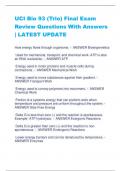
-
UCI Bio 93 (Trio) Final Exam Review Questions With Answers | LATEST UPDATE
- Exam (elaborations) • 28 pages • 2024
-
- $12.99
- + learn more
UCI Bio 93 (Trio) Final Exam Review Questions With Answers | LATEST UPDATE How energy flows through organisms. - ANSWER Bioengernetics Used for mechanical, transport, and chemical work. ATP is also an RNA nucleotide. - ANSWER ATP Energy used in motor proteins and muscle cells during contractions. - ANSWER Mechanical Work Energy used to move substances against their gradient. - ANSWER Transport Work Energy used to convey polymers into monomers. - ANSWER Chemical Work Portion of a syst...
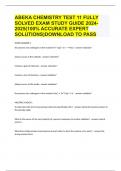
-
Abeka Chemistry Test 11 fully solved exam study guide 2024-2025(100% accurate expert solutions)download to pass
- Exam (elaborations) • 6 pages • 2024
- Available in package deal
-
- $15.49
- + learn more
SHORT ANSWER I: the process iron undergoes in the reaction Fe³⁺(aq) + 3 e⁻ → Fe(s) reduction* always occurs at the cathode reduction* Brainpower Read More Previous Play Next Rewind 10 seconds Move forward 10 seconds Unmute 0:00 / 0:15 Full screen involves a gain of electrons reduction* involves a loss of electrons oxidation* Always occurs at the anode oxidation* the process zinc undergoes in the reaction Zn(s) → Zn²⁺(aq) + 2 e⁻...
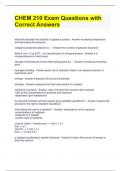
-
CHEM 210 Exam Questions with Correct Answers
- Exam (elaborations) • 2 pages • 2024
-
- $7.99
- + learn more
CHEM 210 Exam Questions with Correct Answers what will decrease the solubility of gaseous solutes - Answer-increasing temperature and decreasing the pressure colligative properties depend on... - Answer-the number of particles dissolved delta S univ < 0 at 25*C... is it spontaneous or nonspontaneous - Answer-it is nonspontaneous at room temp. stronger intermolecular forces effect boiling point by... - Answer-increasing the boiling point hydrogen bonding - Answer-gives rise to hydra...
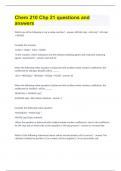
-
Chem 210 Chp 21 questions and answers
- Exam (elaborations) • 5 pages • 2023
-
Available in package deal
-
- $14.99
- + learn more
Which one of the following is not a redox reaction? Al(OH)4-(aq) + 4H+(aq) ® Al3+(aq) + 4H2O(l) Consider the reaction CuO(s) + H2(g) ® Cu(s) + H2O(l) In this reaction, which substances are the oxidant (oxidizing agent) and reductant (reducing agent), respectively? CuO and H2 When the following redox equation is balanced with smallest whole number coefficients, the coefficient for nitrogen dioxide will be _____. I2(s) + HNO3(aq) ® HIO3(aq) + NO2(g) + H2O(l) 10 When t...
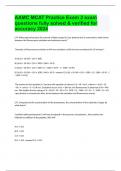
-
AAMC MCAT Practice Exam 2 exam questions fully solved & verified for accuracy 2024
- Exam (elaborations) • 72 pages • 2024
- Available in package deal
-
- $16.99
- + learn more
C/P: What expression gives the amount of light energy (in J per photon) that is converted to other forms between the fluorescence excitation and emission events? "intensity of fluorescence emission at 440 nm excitation at 360 nm) was monitored for 20 minutes" A) (6.62 × 10-34) × (3.0 × 108) B) (6.62 × 10-34) × (3.0 × 108) × (360 × 10-9) C) (6.62 × 10-34) × (3.0 × 108) × [1 / (360 × 10-9) - 1 / (440 × 10-9)] D) (6.62 × 10-34) × (3.0 × 108) / (440 × 10-9) C) (6.62 × ...
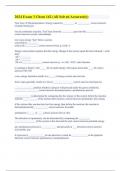
-
2024 Exam 3 Chem 162 (All Solved Accurately)
- Exam (elaborations) • 7 pages • 2023
-
Available in package deal
-
- $11.19
- + learn more
First Law of Thermodynamics: Energy cannot be _________ or __________. correct answers Created; Destroyed For an exothermic reaction, "lost" heat from the _________ goes into the _____________. correct answers system; surroundings two ways energy "lost" from a system, converted to _____,___ used to do _______,___ correct answers heat, q; work, w Energy conservation requires that the energy change in the system equal the heat released + work done ΔE = ________ ΔE = ________ ...
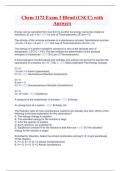
-
Chem 1172 Exam 3 Blend (CSCC) with Answers
- Exam (elaborations) • 6 pages • 2024
-
Available in package deal
-
- $8.99
- + learn more
Energy can be converted from one form to another but energy cannot be created or destroyed. (E.univ = 0) - 1st Law of Thermodynamics (E.univ = 0) The entropy of the universe increases in a spontaneous process. Spontaneous process ( S.univ = S.sys + S.surr ) - 2nd Law of Thermodynamics (S.univ > 0) The entropy of a perfect crystalline substance is zero at the absolute zero of temperature, (-273 C = 0 K). This law enables the determination of the absolute antropies of substances - 3rd ...

-
OpenStax Microbiology Test Bank Chapter 8: Microbial Metabolism
- Exam (elaborations) • 21 pages • 2024
-
- $15.49
- + learn more
OpenStax Microbiology Test Bank Chapter 8: Microbial Metabolism * = Correct answer Multiple Choice 1. Which of the following refers to the term metabolism? A. all the reactions in a cell or organism* B. all the reactions in a cell that break down molecules only C. all the reactions in a cell that build new molecules only D. all the reactions in a cell that decompose molecules only Difficulty: Easy ASM Standard: N/A 2. Which of the following best describes an endergonic reaction? ...

$6.50 for your textbook summary multiplied by 100 fellow students... Do the math: that's a lot of money! Don't be a thief of your own wallet and start uploading yours now. Discover all about earning on Stuvia


